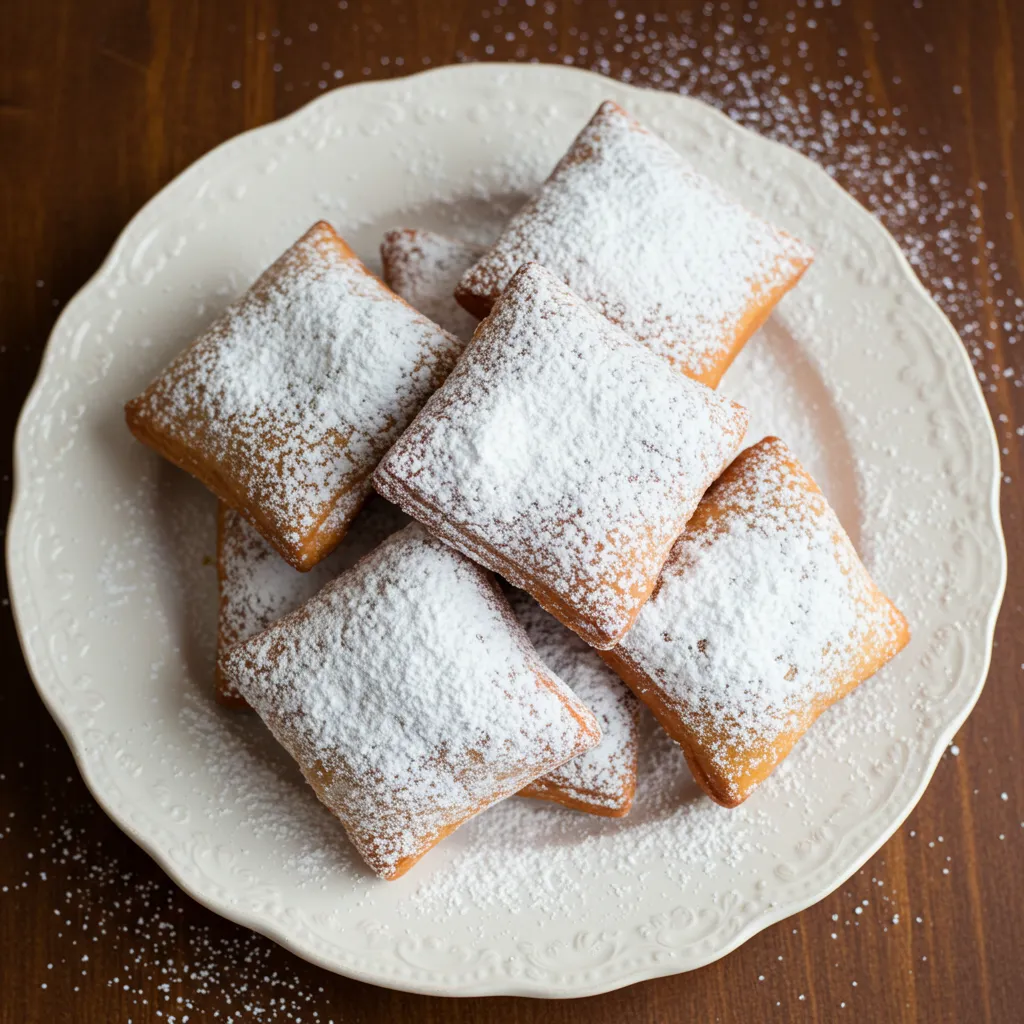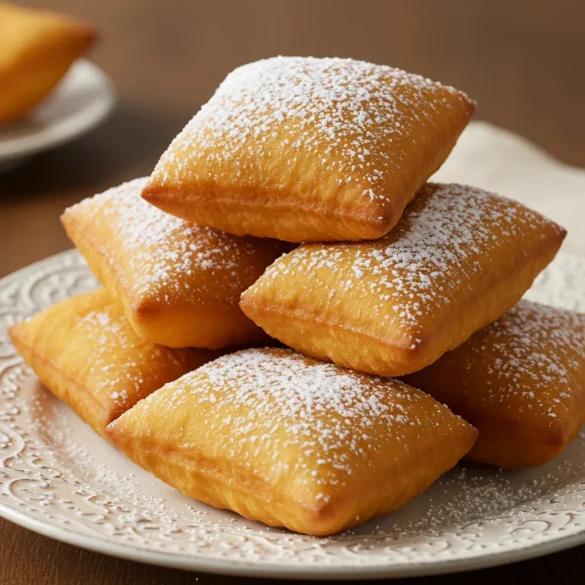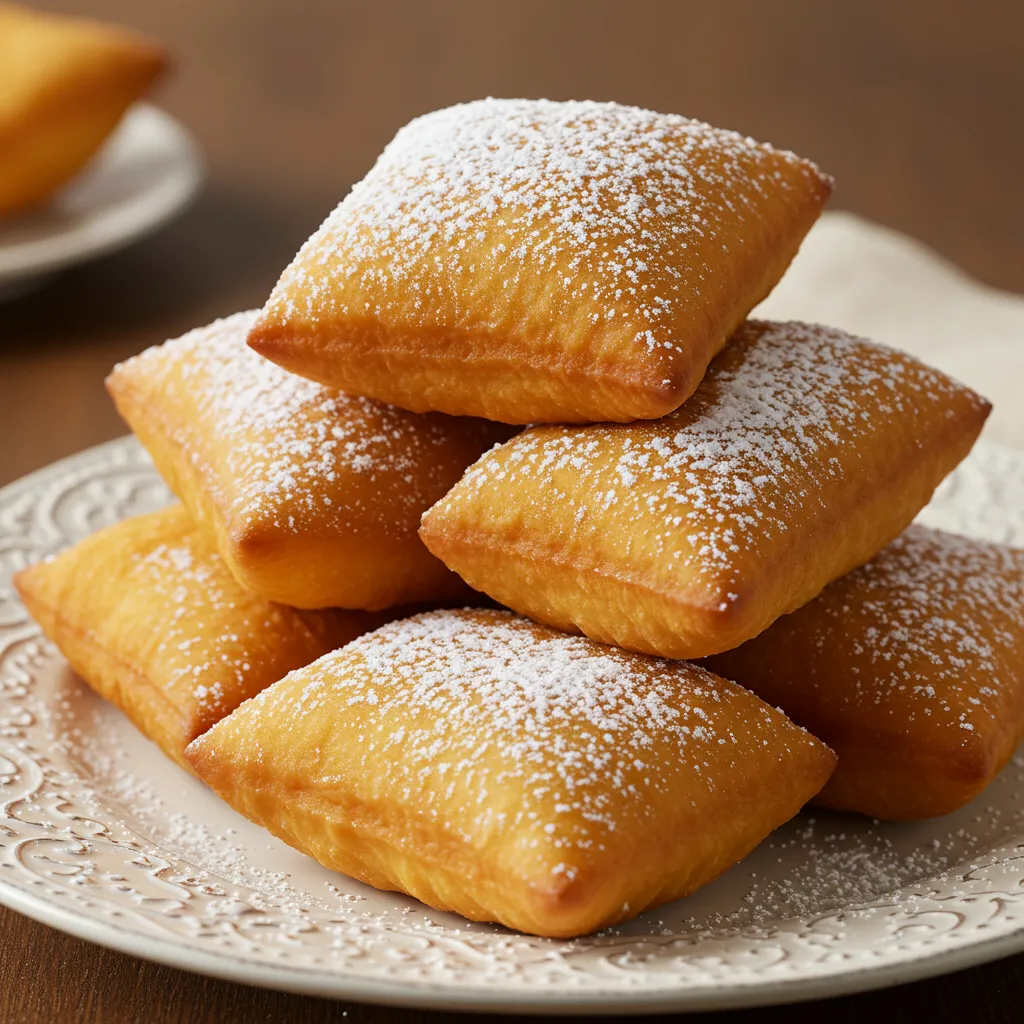These pillowy, golden Vanilla French Beignets are a New Orleans classic that bring a touch of café culture right to your kitchen. Light and airy on the inside with a delicate crispness on the outside, these square French-style donuts are generously dusted with powdered sugar for the perfect sweet treat. Whether enjoyed for breakfast with a strong cup of coffee or served as a delightful dessert, these beignets deliver an authentic taste of Louisiana’s most beloved pastry.
Why You’ll Love This Recipe
- Authentic taste: Captures the true flavor and texture of classic New Orleans beignets
- Perfect texture: Achieves that ideal balance of light interior and golden exterior
- Versatile serving options: Works as breakfast, brunch, dessert, or special occasion treat
- Crowd-pleaser: Guaranteed to impress family and friends with homemade pastry skills
- Make-ahead friendly: Dough can be prepared in advance for fresh beignets anytime
Ingredients
For the Dough
- All-purpose flour – Creates the structure while keeping the texture light
- Granulated sugar – Adds sweetness and helps with browning
- Active dry yeast – Provides the rise and airy texture essential to perfect beignets
- Salt – Enhances flavor and balances sweetness
- Whole milk – Adds richness and provides liquid for the dough
- Butter – Creates tender texture and adds flavor
- Egg – Provides structure and richness
- Vanilla extract – Infuses the dough with warm, aromatic vanilla notes
- Vegetable oil – For frying the beignets to golden perfection
For the Topping
- Powdered sugar – The classic, generous dusting that defines beignets
Step-by-Step Instructions
Preparing the Dough
Begin by activating the yeast. In a small saucepan, gently warm 1 cup of milk to about 110°F (43°C) – it should feel warm but not hot to the touch, as excessive heat will kill the yeast. Remove from heat and add 2¼ teaspoons (one packet) of active dry yeast and 2 tablespoons of granulated sugar. Stir gently and let this mixture stand for about 5-10 minutes until it becomes frothy and foamy, indicating that the yeast is active and ready to use.
While the yeast is activating, melt 2 tablespoons of unsalted butter and allow it to cool slightly. The butter should be melted but not hot when incorporated into the dough.
In a large mixing bowl, combine 3½ cups of all-purpose flour and ½ teaspoon of salt, whisking to distribute the salt evenly. Once the yeast mixture is foamy, add it to the flour along with the melted butter, 1 large egg (at room temperature), and 2 teaspoons of pure vanilla extract. The vanilla is the key flavoring agent that differentiates these beignets, so use the best quality extract you can.
Mix the ingredients until they come together, either using a wooden spoon or the paddle attachment of a stand mixer on low speed. Once the dough begins to form, increase to medium speed (or transfer to a floured surface if mixing by hand) and knead for about 5-7 minutes until smooth and elastic. The dough should be slightly tacky but not overly sticky – if it’s too sticky, add a little more flour, a tablespoon at a time; if too dry, add a touch more milk.
First Rise
Form the dough into a ball and place it in a large, lightly oiled bowl, turning once to coat the surface with oil. Cover the bowl with plastic wrap or a clean kitchen towel and set in a warm, draft-free location to rise until doubled in size, approximately 1 to 1½ hours. The ideal rising temperature is around 75-80°F (24-27°C).
This first rise is crucial for developing the flavor and texture of the beignets. The yeast consumes the sugars in the dough, producing carbon dioxide that creates the air pockets responsible for the light, airy interior of perfectly made beignets.
Rolling and Cutting
Once the dough has doubled in size, gently punch it down to release excess air bubbles. Transfer to a lightly floured surface and roll out to a rectangle approximately ¼-inch thick. Using a sharp knife or pizza cutter, cut the dough into 2½-inch squares. A ruler can be helpful for ensuring uniform size, which promotes even cooking.
Avoid the temptation to re-roll scraps, as this can toughen the dough. Instead, the odd-shaped edge pieces can be fried as they are – they may not look as perfect, but they’ll taste just as delicious!
Place the cut squares on parchment-lined baking sheets, leaving some space between them. Cover loosely with a clean kitchen towel and allow them to rest and rise slightly for about 30 minutes while you prepare the frying oil. This short second rise gives the beignets extra lightness.
Frying the Beignets
Pour vegetable oil into a heavy-bottomed Dutch oven or deep skillet to a depth of about 2-3 inches. Heat the oil to 350-360°F (175-182°C). It’s strongly recommended to use a candy/deep-fry thermometer to monitor the temperature, as maintaining the correct oil temperature is perhaps the most critical factor in achieving perfect beignets.
If the oil is too cool, the beignets will absorb too much oil and become greasy; if too hot, they’ll brown too quickly on the outside while remaining doughy inside. The ideal temperature produces beignets that are golden brown and cooked through in about 2-3 minutes total.
Working in batches of 3-4 beignets at a time (avoid overcrowding the pan), carefully lower the dough squares into the hot oil. The beignets should immediately float to the surface. Fry for about 1-2 minutes per side, using a slotted spoon or spider strainer to gently flip them when the bottom side is golden brown.
Once both sides are evenly golden, remove the beignets and place them on a wire rack positioned over a baking sheet to drain excess oil. Allow them to cool just slightly – about 30 seconds to 1 minute – before dusting with powdered sugar.
The Perfect Powdered Sugar Finish
Place about 2 cups of powdered sugar in a fine-mesh sieve and generously dust the beignets while they’re still warm. The residual heat helps the sugar adhere to the surface. In authentic New Orleans style, the coating should be abundant – these treats are meant to be gloriously messy with sugar!
For an extra-professional touch, you can dust the beignets a second time after about 1 minute. This double-dusting ensures complete coverage and creates that classic snow-white appearance that makes beignets instantly recognizable.
Serve the beignets immediately while still warm for the most authentic experience. Traditionally, they’re accompanied by café au lait (coffee with hot milk) or chicory coffee, the perfect bitter counterpoint to the sweet, pillowy pastries.

Pro Tips
- Maintain oil temperature between 350-360°F for perfect frying
- Use a thermometer – guessing oil temperature leads to inconsistent results
- Allow the dough to rest after cutting for extra light beignets
- Fry in small batches to maintain oil temperature
- Dust with powdered sugar while still warm for better adhesion
Storage and Make-Ahead Advice
Beignets are at their absolute best when freshly made and served warm. However, there are several ways to prepare components ahead of time for convenience.
The dough can be made up to 24 hours in advance and stored in the refrigerator after the first rise. Simply punch down the risen dough, place it in an airtight container or plastic bag, and refrigerate. When ready to use, allow the dough to come to room temperature for about 30 minutes before rolling out and cutting.
For longer storage, the dough can be frozen after the first rise. Wrap it tightly in plastic wrap, then place in a freezer bag with all air removed. Freeze for up to 1 month. Thaw overnight in the refrigerator, then allow to come to room temperature before proceeding with the recipe.
If you find yourself with leftover fried beignets (a rare occurrence!), they can be stored at room temperature in an airtight container for 1-2 days. Reheat them in a 350°F (175°C) oven for about 5 minutes to restore some of their texture, then dust with fresh powdered sugar before serving.
For the best experience, however, calculate quantities to make only what you’ll consume immediately. There’s simply no substitute for the ethereal texture of freshly fried, warm beignets dusted with powdered sugar.
Variations and Creative Ideas
While traditional New Orleans beignets are perfection in their simplicity, there are several delicious variations you might enjoy:
Flavor Infusions
- Citrus Zest: Add 1 tablespoon of orange or lemon zest to the dough for a subtle citrus note that complements the vanilla beautifully.
- Spiced Beignets: Incorporate ½ teaspoon of cinnamon or cardamom into the dough for a warm, aromatic twist.
- Bourbon Vanilla: Replace 1 tablespoon of the milk with bourbon and increase the vanilla extract to 1 tablespoon for an adult version with complex flavor.
Serving Suggestions
- Chocolate Dipping Sauce: Serve alongside a pot of warm chocolate sauce for dipping – simply heat 1 cup of heavy cream and pour over 8 ounces of chopped dark chocolate, stirring until smooth.
- Caramel Drizzle: Drizzle with homemade or store-bought caramel sauce instead of (or in addition to) the powdered sugar dusting.
- Fruit Compote: Offer a berry or stone fruit compote on the side for a refreshing contrast to the rich, fried dough.
Creative Presentations
- Beignet Sundae: Place a warm beignet in a bowl, top with vanilla ice cream, and finish with chocolate or caramel sauce for an indulgent dessert.
- Beignet French Toast: If you happen to have day-old beignets, slice them horizontally and use them to make an over-the-top French toast.
- Mini Beignet Bites: Cut the dough into 1-inch squares for bite-sized treats perfect for brunches or parties.
The History and Tradition of Beignets
Beignets have a rich history that dates back to ancient Rome, but the version we know today came to Louisiana with French colonists in the 18th century. The French settlers adapted their traditional fried dough recipes to use ingredients available in the New World, and over time, beignets became synonymous with New Orleans cuisine.
In 1986, the beignet was designated the official state doughnut of Louisiana, cementing its cultural significance. The most famous place to enjoy these treats is Café du Monde in New Orleans’ French Quarter, which has been serving beignets and coffee since 1862.
Traditionally, beignets are served in orders of three, generously dusted with powdered sugar, and accompanied by chicory coffee or café au lait. They’re typically enjoyed for breakfast or as a late-night indulgence after an evening in the French Quarter.
By making this recipe at home, you’re participating in a culinary tradition that spans continents and centuries. Each pillowy, sugar-dusted square connects you to the rich cultural heritage of New Orleans and the French influence that shaped its distinctive cuisine.
Frequently Asked Questions
Why didn’t my beignets puff up? This usually occurs when the yeast wasn’t properly activated or the dough didn’t rise sufficiently. Ensure your yeast is fresh and that the milk isn’t too hot when activating it. Also, give the dough adequate time to rise in a warm environment.
My beignets are too oily. What went wrong? Oil temperature is the likely culprit. If the oil is too cool (below 350°F), the beignets absorb excess oil instead of immediately forming a crisp exterior. Always use a thermometer and maintain the oil temperature between 350-360°F.
Can I make these without a stand mixer? Absolutely! People were making beignets long before stand mixers existed. Simply mix the ingredients with a wooden spoon until combined, then turn out onto a floured surface and knead by hand for 8-10 minutes until smooth and elastic.
Is it necessary to let the dough rest after cutting and before frying? While not absolutely necessary, this 30-minute rest allows the gluten to relax and gives the yeast a final chance to create more air bubbles, resulting in lighter, puffier beignets.
Can I use all-purpose flour instead of bread flour? Yes, all-purpose flour works well in this recipe. Bread flour will give a slightly chewier texture due to its higher protein content, but the difference is subtle in beignets.

Ingredients
- 3½ cups all-purpose flour, plus more for rolling
- 2¼ teaspoons (1 packet) active dry yeast
- 2 tablespoons granulated sugar
- ½ teaspoon salt
- 1 cup whole milk
- 2 tablespoons unsalted butter
- 1 large egg, at room temperature
- 2 teaspoons pure vanilla extract
- Vegetable oil for frying (about 2 quarts)
- 2 cups powdered sugar for dusting
Instructions
- In a small saucepan, heat milk to 110°F (43°C). Remove from heat, add yeast and sugar, and let stand for 5-10 minutes until foamy.
- Meanwhile, melt butter and let cool slightly.
- In a large bowl, whisk together flour and salt.
- Add the yeast mixture, melted butter, egg, and vanilla extract to the flour. Mix until combined, then knead for 5-7 minutes until smooth and elastic.
- Place dough in an oiled bowl, cover, and let rise in a warm place until doubled in size, about 1-1½ hours.
- Punch down dough and turn out onto a floured surface. Roll to ¼-inch thickness and cut into 2½-inch squares.
- Place squares on parchment-lined baking sheets, cover with a towel, and let rest for 30 minutes.
- Heat oil to 350-360°F (175-182°C) in a deep pot.
- Fry beignets in small batches, 1-2 minutes per side, until golden brown.
- Drain on a wire rack, then dust generously with powdered sugar while still warm.
- Serve immediately for the best experience.
Notes
- The dough should feel slightly tacky but not stick to your fingers
- Watch the oil temperature carefully – too hot and they'll burn, too cool and they'll be greasy
- Use a spider strainer for safer, easier transfer in and out of the hot oil
- For picture-perfect beignets, use a ruler when cutting the dough into squares
- These are best enjoyed with coffee or hot chocolate to balance the sweetness

